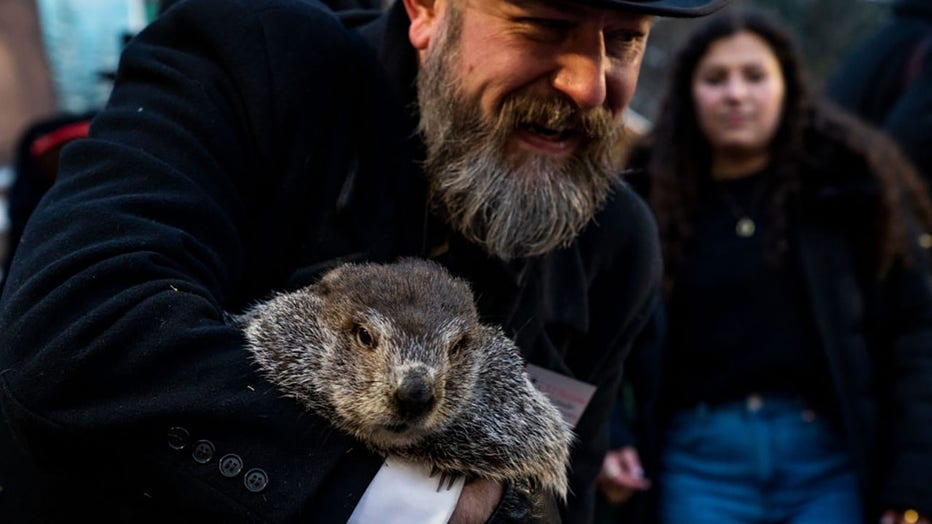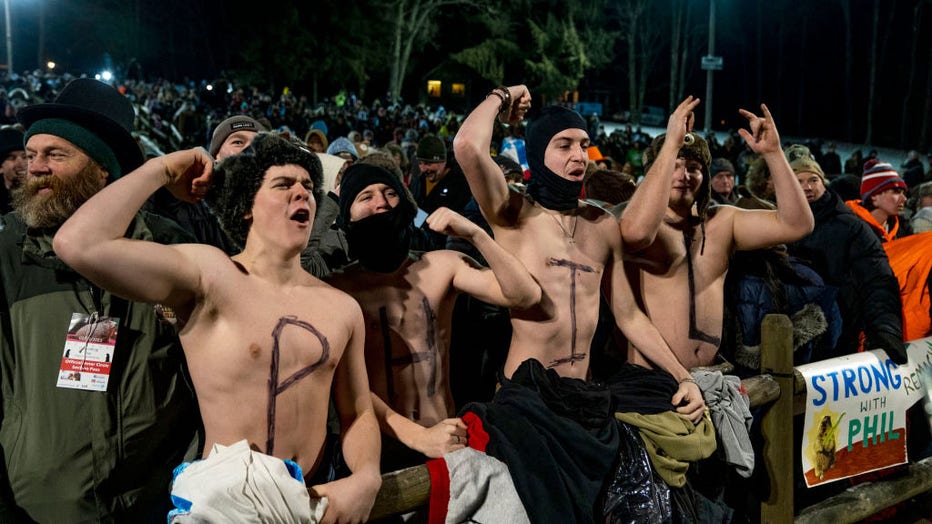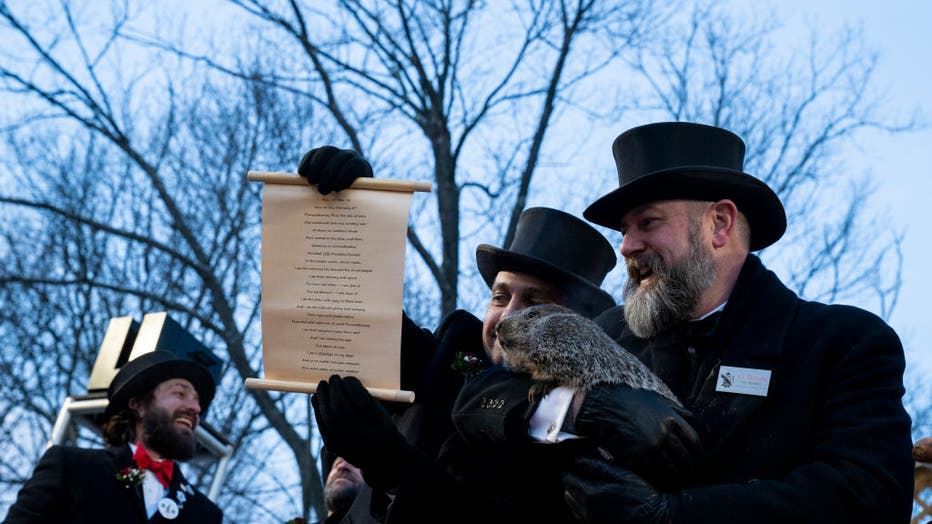Groundhog Day 2023: Punxsutawney Phil sees shadow, predicts 6 more weeks of winter
Punxsutawney Phil, Pennsylvania’s most famous groundhog, awoke Thursday morning and saw his shadow — which, according to folklore, means there will be six more weeks of winter.
Each year on Feb. 2, thousands descend on Gobbler's Knob in Punxsutawney, Pennsylvania, to watch the giant rodent make his annual weather prediction at dawn with the help of his "inner circle" — a group of local dignitaries who are responsible for planning the events, as well as feeding and caring for Phil himself.
According to the legend, there will be six more weeks of winter if he sees his shadow. If he doesn’t, spring comes early.
"I see that everyone knows their part, and I am merely the sage, but above all else, I see a shadow on my stage. And so, no matter how you measure, it’s six more weeks of winter weather," Phil’s handler read aloud from a scroll early Thursday to a crowd of thousands.

Groundhog handler AJ Derume holds Punxsutawney Phil, who saw his shadow, predicting a late spring during the 136th annual Groundhog Day festivities on Feb. 2, 2023, in Punxsutawney, Pennsylvania. Groundhog Day is a popular tradition in the United Sta
For the past two years, Phil predicted six more weeks of winter. His 2020 forecast called for an early spring.
The groundhog tradition is thought to have originated in the 1800s and over time has become a staple in America’s culture. Thousands of people this year spent the early morning hours celebrating and awaiting the groundhog’s exit from his winter den.
The event took place virtually in 2021 because of the coronavirus pandemic, depriving the community, about 65 miles northeast of Pittsburgh, of a boost from tourists. Last year, thousands returned to celebrate the annual event.

A crowd of people await to see Phil on Feb. 2, 2023, in Punxsutawney, Pennsylvania. Groundhog Day is a popular tradition in the United States and Canada. (Photo by Michael Swensen/Getty Images)
Groundhog Day prediction accuracy
Records kept by the Punxsutawney Groundhog Club show Phil has predicted 107 continued winters and only 20 early springs as of 2023. According to the Stormfax Almanac, that works out to a 39% accuracy rate for Phil.
In the near term, the groundhog’s accuracy rate is slightly better. According to the National Oceanic and Atmospheric Administration, Phil has been right about 40% of the time on average over the past decade.
In 2021, Phil predicted more winter. According to NOAA, his forecast was about half right. February 2021 was the coldest since 1989, but March turned out to be warmer than normal.
Phil saw his shadow again in 2022, which meant another prediction of a continued winter. NOAA experts said he again missed the mark. While February was slightly colder than average, March's temperatures were much warmer than average.
Forget the groundhog prediction: 7 animals who will give Punxsutawney Phil a run for his money
Groundhog Day origin: History of the annual tradition

Landon Cook, Aiden Cameron, Sawyer Hall and Matt Grusky cheer during a concert on Feb. 2, 2023, in Punxsutawney, Pennsylvania. (Photo by Michael Swensen/Getty Images)
The celebration of Groundhog Day began with Pennsylvania's earliest settlers, according to the groundhog club. They brought with them the legend of Candlemas Day, which states, "For as the sun shines on Candlemas Day, so far will the snow swirl in May...," the club notes on its website.
The ancient Christian tradition of Candlemas included clergy blessing and distributing candles needed for winter. The candles represented how long and cold the winter would be, History.com notes. Germans expanded on this by selecting an animal — the hedgehog — as a means of predicting the weather.
"Once they came to America, German settlers in Pennsylvania continued the tradition, although they switched from hedgehogs to groundhogs, which were plentiful in the Keystone State," the outlet writes.
Punxsutawney held its first Groundhog Day in the 1800s. The first official trek to Gobbler's Knob — a tiny hill just outside of the town — wasn't made until Feb. 2, 1887. That year, Phil saw his shadow.
His first prediction of six more weeks of winter was accurate for a few regions, but it came up short for several others, according to the NOAA.
Why is the groundhog’s name Phil?
Punxsutawney Phil was named after "King Phillip," the Punxsutawney Groundhog Club states online — without further elaboration.
Some news outlets have noted that "King Philip" may refer to the English name given to Metacomet, the chief of the Wampanoag people who formerly occupied parts of present-day Rhode Island and Massachusetts.
Prior to being called Phil, he was called Br'er Groundhog, according to the club.

Vice President Dan McGinley shows a scroll to the crowd as Groundhog handler AJ Derume holds Punxsutawney Phil, who saw his shadow, predicting a late spring during the 136th annual Groundhog Day festivities on Feb. 2, 2023, in Punxsutawney, Pennsylva
Other US groundhog predictions
While Phil has grown in popularity over the years, there are other rodent weather forecasters out there. Buckeye Chuck, Ohio’s chief prognosticating groundhog since 1979, saw his shadow just like Phil.
Georgia's famous groundhog, General Beauregard "Beau" Lee, made his big weather forecast for 2023 and did not see his shadow – meaning an early spring. New York City’s Staten Island Chuck made his prediction during an event at the Staten Island Zoo, also forecasting an early spring.
The same went for French Creek Freddie, a groundhog in West Virginia whose prediction suggested that spring is near.
Elsewhere, onlookers normally flock to Groundhog Day festivities in Milltown, New Jersey, to catch a glimpse of another groundhog celebrity named Milltown Mel. Last year, it was revealed that the weather-predicting rodent died just before his annual big day and the town canceled the event because the wranglers didn’t have enough time to find a replacement.
This year, the organizers found a new forecaster, but the event was canceled again due to an unforeseen legal obstacle, according to reports.
This story was reported from Cincinnati. The Associated Press contributed.


